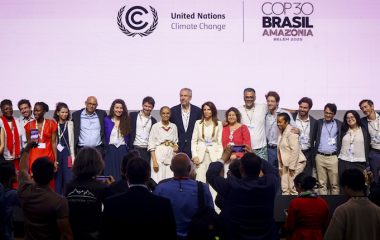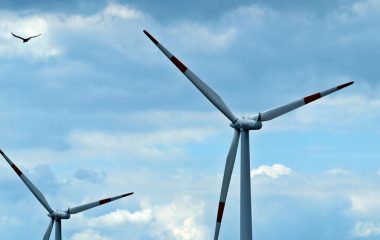
Share
Ana Colovic Lesoska, executive director at the Center for environmental research and information Eko-svest from Skopje, is one of six winners of the 2019 Goldman Environmental Prize, a first for the prestigious award to go to North Macedonia.
This recognition followed Colovic Lesoska’s successful campaign to halt international lending for two hydropower plants, thereby protecting the habitat of the Balkan lynx, an endangered species. In an interview with Balkan Green Energy News, Colovic Lesoska discusses the campaign, why it was worth the struggle, why environmental activists should persevere in their fight for worthy causes, and why Georgia’s Nenskra hydropower project should not proceed.
You are North Macedonia’s first-ever recipient of the prestigious Goldman Environmental Prize. Do you think this recognition will make decision-makers in the country more open to what environmental activists have to say?
Environmental activists have a challenging task – to speak on behalf of something that does not have its own voice. Therefore, their role in society should be taken seriously. I think decision makers in the country should not try to avoid the messages coming from environmental activists, if they wish to learn how to build true partnership with civil society.
The Goldman Environmental award drew the eyes of the entire world to our country and the way we treat our environment and natural habitats. Now, the decision makers have to demonstrate, that they have learned the lessons and they are ready to do better.
The award recognizes your successful campaign to halt international lending for two hydropower plants, which is credited for protecting the habitat of the Balkan lynx. Can you tell us more about the threats that these hydropower projects were posing? And what were the biggest campaign challenges?
The planned hydropower projects were located in the Mavrovo national park, and therefore, any impact they would have had if built, would have been even more devastating, due to the high biodiversity and good ecological status of the area. Major impacts would have been on river and surrounding habitats, including fragmentation of many different habitats. Apart from the otter, fish and other endemic and rare aquatic species, which would have been obviously impacted, these projects, due to their massive infrastructure nature would have also impacted the reproductive core area of the critically endangered Balkan lynx, including its prey.
One of the most challenging things in the campaign was the absence of counterparts in the Government – our concerns were not being heard, even ignored for a very long time. The claims we made from the very beginning needed to be repeated by many different sources (scientists, local people, international experts and institutions) in order for the Government to actually hear them. Moreover, we found it easier to speak to international financial institutions (IFIs) than with our own officials. Often, this may be the only way to convey the message to the right address.
We found it easier to speak to IFIs than with our own officials – often, this may be the only way to convey the message to the right address
Do you think all hydropower plants are damaging and undesirable or is this the case only with small hydropower plants or a specific type of small hydropower plants?
I definitely think that the construction of all infrastructure projects inside protected areas with high biodiversity has a detrimental impact to nature and should not be allowed. These areas are declared as protected for a good reason and they should be preserved undamaged. As for hydropower plants, my experience from numerous field visits shows that even the perfectly constructed traditional type of hydropower plant still causes serious damage to the ecosystems and species. Large dams and reservoirs are also contributors to climate change and small hydropower leave dry riverbeds and result in loss of species and dead rivers.
Even the perfectly constructed traditional type of hydropower plant still causes serious damage
That is why we must seriously think where we locate hydropower, if at all. Unlike the “independent” wind and solar, hydropower must be placed on a specific location – rivers, which are source of drinking water for people and source of life for ecosystems. Governments must have strict criteria and standards for hydropower and clear vision where such projects could be allowed and under which conditions, if absolutely necessary.
Unlike the “independent” wind and solar, hydropower must be placed on a specific location – rivers, which are source of drinking water for people and source of life for ecosystems
What is your advice to environmental activists who may not see the light at the end of the tunnel in their own campaigns against projects that would have an adverse environmental impact?
Do not give up and do not let threats, pressure and disappointments make you lose sight of your goal. You began this campaign for a reason and if you do not see this through, maybe there will be no one else who would.
Always focus your passion on the positive outcomes and take the time to celebrate even the small successes – it might take a long time before you win it all!
You have used the spotlight you received thanks to the award to draw attention to the Nenskra hydropower project planned in Georgia. Can you tell us more about the project’s environmental implications?
The Nenskra dam, planned in an Emerald site in the Svaneti region in Georgia, is impacting both natural heritage and a local population of indigenous Svan community.
Nenskra* is one of several dams planned in the Enguri river basin, upstream of the state-owned 1300 MW Enguri hydropower plant. The water accumulation at Nenskra will inevitably reduce water levels downstream, and lessen the economic utility of the Enguri dam and the planned Khudoni dam.
More importantly, the Georgian government has not tried to assess the cumulative impacts of all the planned hydro installations on the Enguri watershed and the Upper Svaneti region.
Besides the dams and derivation tunnels, the necessary constructions include bypass and access roads, high voltage transmission lines and substations. These may lead to substantial increase in landslides and thus sedimentation in the already exposed Enguri dam.
* Eko-svest is a member of CEE Bankwatch Network. Follow the link for more information about the Nenskra project.


















Be the first one to comment on this article.